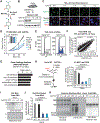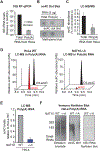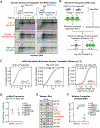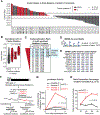Acetylation of Cytidine in mRNA Promotes Translation Efficiency
- PMID: 30449621
- PMCID: PMC6295233
- DOI: 10.1016/j.cell.2018.10.030
Acetylation of Cytidine in mRNA Promotes Translation Efficiency
Abstract
Generation of the "epitranscriptome" through post-transcriptional ribonucleoside modification embeds a layer of regulatory complexity into RNA structure and function. Here, we describe N4-acetylcytidine (ac4C) as an mRNA modification that is catalyzed by the acetyltransferase NAT10. Transcriptome-wide mapping of ac4C revealed discretely acetylated regions that were enriched within coding sequences. Ablation of NAT10 reduced ac4C detection at the mapped mRNA sites and was globally associated with target mRNA downregulation. Analysis of mRNA half-lives revealed a NAT10-dependent increase in stability in the cohort of acetylated mRNAs. mRNA acetylation was further demonstrated to enhance substrate translation in vitro and in vivo. Codon content analysis within ac4C peaks uncovered a biased representation of cytidine within wobble sites that was empirically determined to influence mRNA decoding efficiency. These findings expand the repertoire of mRNA modifications to include an acetylated residue and establish a role for ac4C in the regulation of mRNA translation.
Keywords: N4-acetylcytidine; NAT10; epitranscriptome; mRNA stability; mRNA translation.
Published by Elsevier Inc.
Conflict of interest statement
Figures







Comment in
-
N4-acetylation of Cytidine in mRNA by NAT10 Regulates Stability and Translation.Cell. 2018 Dec 13;175(7):1725-1727. doi: 10.1016/j.cell.2018.11.037. Cell. 2018. PMID: 30550783
-
mRNA acetylation: a new addition to the epitranscriptome.Cell Res. 2019 Feb;29(2):91-92. doi: 10.1038/s41422-018-0135-2. Cell Res. 2019. PMID: 30631155 Free PMC article. No abstract available.
References
-
- Agris PF, Vendeix FA, and Graham WD (2007). tRNA’s wobble decoding of the genome: 40 years of modification. J Mol Biol 366, 1–13. - PubMed
-
- Bailey TL, and Elkan C (1994). Fitting a mixture model by expectation maximization to discover motifs in biopolymers. Proc Int Conf Intell Syst Mol Biol 2, 28–36. - PubMed
Publication types
MeSH terms
Substances
Grants and funding
LinkOut - more resources
Full Text Sources
Other Literature Sources
Molecular Biology Databases
Research Materials

